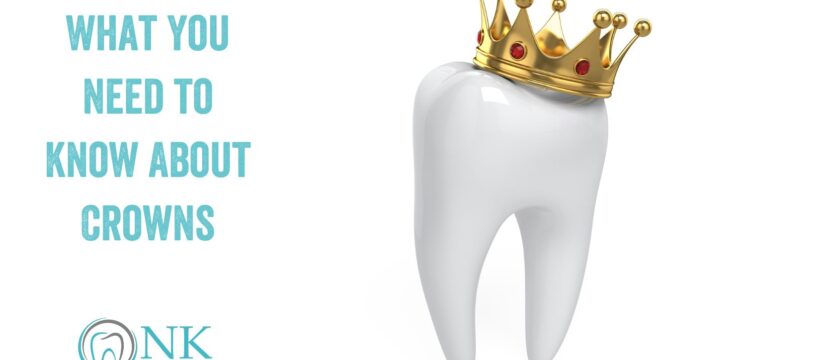
Dental crowns are a popular solution to restore teeth that are damaged or have undergone a root canal — as well as a durable, long-term cosmetic restoration for teeth that are permanently discolored and/or irregularly shaped or spaced. Whether you need only one crown, or are considering a smile makeover, knowing why your dentist may recommend a crown and learning about the various types of crowns available will help you have a better informed conversation with your dentist in considering your options.
Also known as a cap, a dental crown is typically a tooth-colored prosthetic that fits over the entire tooth, down to the gumline. Once inserted, a crown can strengthen the tooth, improving its overall appearance and alignment in the mouth.
Reasons You May Need a Crown
As just mentioned, crowns address a number of restorative issues. Cleveland Clinic provides the following comprehensive list:
- Strengthen a weak tooth.
- Protect and support a cracked tooth.
- Restore a worn-down or broken tooth.
- Hold a dental bridge in place.
- Cover a severely stained or discolored tooth.
- Cover a root canal-treated tooth.
- Cover a dental implant.
Common Materials for Crowns
Dental crowns can be fashioned from a wide range of materials. The following are the most common — along with their advantages and disadvantages.
All-porcelain — Also known as “ceramic,” this is the most popular type of crown, as it provides the most natural look. Porcelain crowns are typically a good choice for the upper front teeth. Because they don’t contain metal, porcelain crowns can’t trigger an allergic reaction. However, they are more susceptible to cracks and chips — which may be an issue for those with bruxism (teeth grinding). Depending upon how well you care for them, porcelain crowns can last for 15 to 30 years.
Porcelain-fused-to-metal (PFM) — As its name indicates, this type of crown combines the durability of metal and the natural look of porcelain. As with all-porcelain crowns, your dentist can match the shade of the crown to your own teeth, or produce a whiter shade if used for a smile makeover. However, the metal base will be exposed should the porcelain chip. If your gums recede, the metal edge will show at the gumline.
Zirconia — Zirconium dioxide is a relatively new material that combines the strength of metal with the aesthetics of porcelain crowns. It is extremely strong without the bulky appearance of traditional porcelain, and its resistance to wear makes it difficult to fracture or crack. However, the material’s default color is bright white translucent. A wider range of shades have recently been introduced, but achieving the patient’s desired shade could be challenging.
E-max — Made of lithium disilicate — a type of ceramic — crowns of this material are strong, resilient and achieve a great aesthetic result. On the down side, it does tend to be more expensive than crowns fashioned of traditional materials.
Gold — Speaking of traditional materials, gold crowns are known for their strength and durability, making them a good choice for molars. Of course, however, they don’t look like natural teeth. As molars typically aren’t visible while smiling, this may not make a difference to you.
What You Can Expect When Getting a Crown
As mentioned earlier, the first step involves talking with your dentist about your options – which takes into consideration such factors as the crown’s placement, your bite, your gum tissue and your budget. If this is part of a smile makeover, you and your dentist will discuss your aesthetic goals — including the desired shade of your crowns. Regardless of the number or location of your crown(s), you’ll have the opportunity to select its shade.
Next, you’ll schedule your first appointment. Getting a crown typically requires two visits. Colgate provides the basic steps that each visit involves:
First visit:
- Trim down the damaged tooth to make room for the crown to fit comfortably.
- Take an impression for the crown by having you bite into impression paste placed on your trimmed tooth. This impression will go to a dental lab that’ll prepare your crown.
- Insert a temporary crown until your permanent crown returns from the dental lab.
Second visit:
- Your dentist will remove the temporary crown and fit the permanent one, making sure it feels right before cementing it into place.
- If needed, a post may be required to build up your tooth up before placing the crown.
How to Make Your Crown Last
While each type of crown material has its own life expectancy, the number of years of useful service you can anticipate varies depending upon the care you give it. It is possible for a crown to last a lifetime! As with your unadorned teeth, avoid biting down on hard foods, don’t chew ice and don’t use your teeth as a bottle opener! If bruxism is a problem, talk to your dentist about available treatments — such as a custom-made dental night guard for your mouth.
Otherwise, practicing good oral hygiene and scheduling twice-yearly checkups with your dentist will go a long way in preserving not only your crowns, but your oral health in general! At NK Family Dental, it is our mission to provide the highest quality and most compassionate oral care to our Chicago patients, including both dental and periodontal services. Our practice is trusted for advanced oral surgery procedures and comfortable root canal treatment.
Our team of experienced, dedicated dental professionals will help address your oral health concerns, and determine the best solution for you based on your individual situation. We strive to identify treatment options that fit your needs.
Our dental specialists include our general dentist, Dr. Nilofer Khan, our endodontist, Dr. Sabek, and our periodontist, Dr. Amir Danesh. Dr. Danesh is a board-certified periodontist and Diplomat of the American Board of Periodontology. He has contributed to the publication of two books, as well as published over 20 papers in prestigious dental research journals.
We serve the neighborhoods of Logan Square, Bucktown, Humboldt Park, and Wicker Park with the dedication that’s earned us the reputation as the Best Dentist in Chicago!
We understand that the main concern you may have is cost, which is why we accept all major PPO plans for dental insurance and also offer our in-house dental plan. Please see our financing page for more information.
Schedule your visit through ZocDoc, or contact us directly. We look forward to treating you soon!
